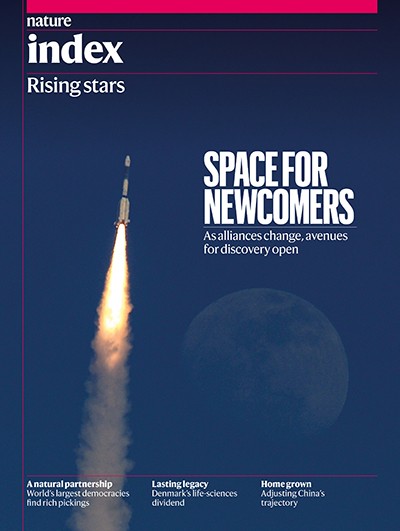China’s rapid rise in global science owes much to its domestic endeavours, but international partnerships have been instrumental in elevating the quality of its research output. Escalating geopolitical tensions have changed the dynamics, however, and in some countries, particularly in the West, a shift in perception towards China from cooperative partner to rival casts a shadow over cross-border collaboration.
On its journey forward, China might have to depend more on its own efforts. This means stimulating bottom-up initiatives that give researchers more autonomy over their work, while reducing top-down interference. By prioritizing research quality, integrity and impact, as well as valuing diversity, risk-taking and interdisciplinarity, universities and research institutions can foster new perspectives and unconventional approaches that could lead to genuine innovation and breakthroughs. At the same time, China cannot afford to be closed off to international partnerships.

Nature Index 2023 Rising stars
To give these initiatives a chance, institutions need to commit to implementing more transparent, merit-based systems for funding and resource-allocation. Incentives for quality research and measures for collaboration are also important. Enticing researchers to build productive networks across disciplines and to engage in globally relevant research could help China grow capacity in disciplines where it has been relatively weak, such as the biological and social sciences. Efforts have been made to integrate the social sciences with technology and engineering disciplines, for example, to better understand the social impacts of emerging fields such as nanotechnology and artificial intelligence, and to drive innovation in digital health and other areas.
As part of the efforts to improve research quality and culture, Chinese institutions need to place an increased emphasis on research ethics, integrity and responsibility and to adapt to evolving global norms in these areas. In addition, by embracing open-access publishing and data sharing, China can reinvigorate its international partnerships. As well as highlighting the accessibility and impact of its research, such practices would surely bolster the reputation and credibility of Chinese science on the world stage.
China’s progress in research and innovation hinges on nurturing a thriving talent pool. The slowdown in Chinese students leaving to study abroad, especially in the United States, could have lingering impacts. China might need to focus on cultivating domestic talent through educational reforms and initiatives that inspire young minds to pursue STEM careers. Chinese institutions must also extend efforts to recruit researchers beyond ethnic Chinese by offering attractive career-development opportunities in China to foreign talent. The success of migrating researchers and the reputation of their institutions would reinforce one another, helping to attract bright international students to compensate for the shortfall of outbound student mobility.
Investment in cutting-edge, ‘big-science’ research infrastructure can also be an effective way to lure global talent and pursue high-quality research collaboration. These facilities, which undertake both basic research and projects with strategic goals, are the foundation of some of the world’s most prestigious national laboratories. Europe’s particle-physics laboratory, CERN, located in Switzerland, runs several large, renowned research infrastructures that host more than 11,000 visiting scientists — a boon for a small nation. The Sirius synchrotron in Brazil and SESAME, the Synchrotron-light for Experimental Science and Applications in the Middle East, based in Jordan, demonstrate an interest from developing economies, too, in hosting big-science infrastructure.
Such facilities often have greater capacity than a single university or research institution to conduct complex, long-term experiments, which can boost a nation’s reputation in specialized areas. Discoveries in high-energy physics and cosmology have won CERN numerous Nobel prizes. The Chinese Academy of Sciences, which faces immense government pressure to build its relevance and reputation as the country’s largest and premier research institution, could invest in new big-science centres to attract top talent and conduct pioneering research (X. Yang et al. Science 379, 240–243; 2023).
Chinese institutions and scientists need to continue reaching out to strengthen, or at least maintain, existing research ties and to diversify their international partnerships. The reluctance of some American scientists in collaborating with Chinese counterparts may have contributed to the recent decline in joint Sino–American publications. In the Nature Index, for example, the bilateral collaboration score between China and the United States has dropped by 15% since 2020. Such collaboration is necessary, especially in addressing climate change, pandemics and other urgent challenges. Rebuilding relationships will be difficult, but achievable, if China continues to appreciate an open research culture that encourages the pooling of resources, expertise and ideas.
China has established itself as a formidable player in research and innovation. Its institutions need to strive to improve environments where the free inquiry of ideas, critical thinking and the questioning of prevailing narratives are facilitated and encouraged. Doing so would not only underpin the country’s upwards trajectory in global science, but also align with China’s innovation-driven development strategy.
